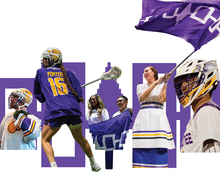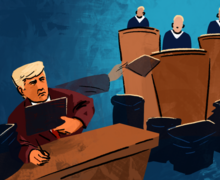SU’S DEIA forum highlights efforts toward inclusivity on campus
Collin Snyder | Contributing Photographer
Mary Grace A. Almandrez, SU's Vice President for Diversity and Inclusion, laid out the Office of Diversity and Inclusion's multi-year strategic priorities plan, highlighting its current focus on learning and development.
Get the latest Syracuse news delivered right to your inbox.
Subscribe to our newsletter here.
During Syracuse University’s biannual diversity, equity, inclusion and accessibility forum, Vice President for Diversity and Inclusion Mary Grace A. Almandrez discussed SU’s most recent efforts to foster a sense of belonging on campus.
Almandrez introduced strategies to create a more inclusive campus. The forum also highlighted updates to the Office of Diversity and Inclusions’ most recent projects, followed by an interactive workshop brainstorming ways to build welcoming environments.
The event opened with an update on new initiatives and activities within the ODI. Almandrez told the audience that students and faculty decide to leave academic institutions when they no longer feel they belong to the community.
“It’s really important that the Office of Diversity and Inclusion shows up,” Almandrez said. “We cannot just show up in moments of crisis … we need to show up consistently, and we need to engage with our community on an ongoing basis.”
Almandrez shared ODI’s three challenges for the fall semester: Be responsive, move from being intuitive to intentional and try to look at everyday routine struggles as “incredible opportunities to be dynamic.” She encouraged the audience members to consider these thought processes when going through daily life.
She proceeded to highlight some achievements made across campus in DEIA, including the completion of SU’s 14th annual Coming Back Together event — where 1,500 Black and Latine alumni returned to campus to network with current students. Almandrez also highlighted the selection of SU Rabbi Ethan Bair and Imam Amir Durić as Interfaith Innovation Scholars for their work in building Jewish-Muslim relations on campus.
“Syracuse University has a long history of inclusion,” Eboni Britt, ODI’s executive director of strategic communications and initiatives, said. “This is a long and proud legacy that we have here, and the work that we do in this office and beyond with our partners continues that legacy of inclusion across campus.”
Almandrez then laid out ODI’s multi-year strategic priorities plan, emphasizing SU’s progress since 2022. She said that, in recent years, ODI has worked to engage with the university community by hosting regular campus forums. She also said the office has increasingly interacted with students and faculty through newsletters and social media outreach.
To grow a more inclusive community, Almandrez said ODI’s focus this year will be on learning and development. ODI is partnering with SU’s Office of Human Resources and the College of Professional Studies to create an inclusive hiring guide, with the long-term goal of hiring a more diverse array of faculty and staff at SU.
In the next three years, ODI will focus on “research and assessment.” Almandrez said her team plans to put out a “campus climate assessment” in 2026 as well as regularly survey students and faculty on their sense of community at SU.

Collin Snyder | Contributing Photographer
Attendees were tasked with coming up with ways to make different scenarios more inclusive and accessible to all people on campus. Ryan Nkongnyu, (center) said it was important for students, faculty and staff to have “perspective” on the needs of different members of the SU community.
Following Almandrez’s update, Armando Martinez, SU’s director of inclusion and belonging, led a workshop on cultivating a sense of belonging.
Martinez guided about 60 attendees through three scenarios focused on fostering belonging among students and staff while enhancing the inclusivity and accessibility of major campus events. Audience members were given 10 minutes to discuss the prompts at their tables, followed by a share-out session.
Participants were encouraged to evaluate four “levers” — including space, events, rituals and communication — as tools to build a sense of belonging. Martinez said these levers originate from Susan Wise’s book, Design for Belonging: How to Build Inclusion and Collaboration in Your Communities.
Ryan Nkongnyu, a senior studying communication and rhetorical studies, said the scenarios allowed community members to explore better methods for making events and spaces on campus more inclusive. He said that, as an upperclassman, he feels a responsibility to leave the university more welcoming for students, faculty and alumni than when he first arrived.
“When one staff member sees me as a student and believes in me, it gives me a sense of belonging that goes far beyond just being with friends from a dorm hall,” Nkongnyu said. “Moments like these will break the chain of loneliness and help students find communities where they feel OK.”
Cliff Davidson, professor emeritus in SU’s Department of Civil and Environmental Engineering, said he believes it’s important to provide direct communication between students and administrators and ensure that student voices are heard. He said there are too many “filters” between students and administration.
“The students who are most likely to feel lonely are the ones who are least likely to come forward and talk about why they are lonely,” Davidson said. “It’d be really good to connect the students who are lonely with senior leaders directly so that they can hear right from their voices.”
Minchin Lewis, an adjunct professor in the Department of Public Administration and International Affairs, said that participating in DEIA is more important than ever because of the current political climate in the United States. Lewis said that there are candidates running for office who could potentially work against future DEIA efforts.
Britt said SU has done a “tremendous” job promoting DEIA and that external factors will not change that.
“The university has had a history of diversity and inclusion and they will continue to make great efforts to ensure everyone on campus feels welcomed, included and that they belong,” Britt said.
DISCLAIMER: Ryan Nkongnyu was previously a staff writer for The Daily Orange’s Culture section. He does not influence the editorial content of the News section nor did he influence the editorial content of this article.
Published on October 31, 2024 at 1:41 am
Contact Duncan: digreen@syr.edu





